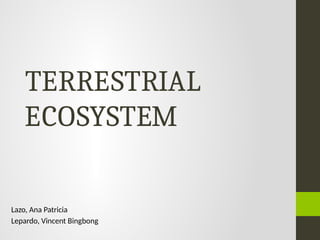
pptx.pdf
- 1. TERRESTRIAL ECOSYSTEM Lazo, Ana Patricia Lepardo, Vincent Bingbong
- 2. WHAT IS TERRESTRIAL ECOSYSTEM? • A community of organisms and their environment that occurs on the land masses of continents and islands • Distinguished from aquatic ecosystem by the lower availability of water and the consequent importance of water as a limiting factor. • Characterized by greater temperature fluctuations on both a diurnal and seasonal basis than occur in aquatic ecosystems in similar climates. • Segmented into a subterranean portion from which most water and ions are obtained, and an atmospheric portion from which gases are obtained and where the physical energy of light is transformed into the organic energy of carbon-carbon bonds through the process of photosynthesis. • There are six primary terrestrial ecosystem that exist: tundra, taiga, temperate deciduous forest, tropical rain forest, grassland and desert.
- 3. SIX PRIMARY ECOSYSTEM • Tundra is type of biome where the tree growth is hindered by low temperatures and short growing seasons.
- 4. • Taiga is a biome characterized by coniferous forests.
- 5. • Temperate deciduous forests or temperate broad-leaf forests are dominated by trees that lose their leaves each year. They are found in areas with warm, moist summers and mild winters
- 6. • Tropical rainforests occur in areas of tropical rainforest climate in which there is no dry season – all months have an average precipitaton value of at least 60 mm – and may also be referred to as lowland equatorial evergreen rainforest
- 7. • Grasslands are areas where the vegetaton is dominated by grasses, however sedge and rush families can also be found.
- 8. • A desert is a barren area of land where litle precipitaton occurs and consequently living conditons are hostle for plant and animal life
- 9. In the history of life (the first terrestrial organisms appeared in the Silurian period, about 425 million years ago) and occupy a much smaller portion of Earth's surface than marine GUCCI FLIP FLOPS ecosystems
- 10. • Terrestrial ecosystems occupy 55,660,000 mi² (144,150,000 km²), or 28.26% of Earth's surface • Terrestrial ecosystems have been a major site of adaptive radiation of both plants and animals.
- 11. Major Plant taxa in terrestrial ecosystems
- 12. Magnoliophyta (flowering plants) - are the most diverse group of land plants, with about 350,000 species. Like gymnosperms, angiosperms are seed-producing plants; they are distinguished from gymnosperms by characteristics including flowers, endosperm within the seeds, and the production of fruits that contain the seeds.
- 13. Pinophyta(conifers) - there are about 500 species. also known as division Coniferophyta or Coniferae, are one of 12 extant division-level taxa within the kingdom Plantae and 10 within the extant land plants. Pinophytes are gymnosperms, cone- bearing seed plants with vascular tissue.
- 14. Bryophyta (mosses and liverworts), of which there are about 24,000 species, are also important in some terrestrial ecosystems. Bryophyte is a traditional name used to refer to all embryophytes (land plants) that do not have true vascular tissue and are therefore called "non-vascular plants".Some bryophytes do have specialized tissues for the transport of water; however, since these do not contain lignin, they are not considered to be true vascular tissue
- 15. Major animal taxa in terrestrial ecosystems
- 16. Insecta (insects) - about 900,000 species. are a class of invertebrates within the arthropod phylum that have a chitinous exoskeleton, a three-part body (head, thorax and abdomen), three pairs of jointed legs, compound eyes and one pair of antennae.
- 17. Aves (birds) - with 8,500 species. a group of endothermic vertebrates, characterised by feathers, a beak with no teeth, the laying of hard-shelled eggs, a high metabolic rate, a four-chambered heart, and a lightweight but strong skeleton.
- 18. Mammalia (mammals) - approximately 4,100 species. are any members of a clade of endothermic amniotes distinguished from reptiles and birds by the possession of a neocortex (a region of the brain), hair, three middle ear bones, and mammary glands. The mammalian brain regulates body temperature and the circulatory system, including the four-chambered heart.
- 19. Organisms in terrestrial ecosystems have adaptatons that allow them to obtain water when the entre body is no longer bathed in that fluid, means of transportng the water from limited sites of acquisiton to the rest of the body, and means of preventng the evaporaton of water from body surfaces. They also have traits that provide body support in the atmosphere, a much less buoyant medium than water, and other traits that render them capable of withstanding the extremes of temperature, wind, and humidity that characterize terrestrial ecosystems. Finally, the organisms in terrestrial ecosystems have evolved many methods of transportng gametes in environments where fluid flow is much less effectve as a transport medium.